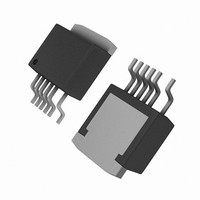DPA424R Power Integrations, DPA424R Datasheet - Page 19

DPA424R
Manufacturer Part Number
DPA424R
Description
IC CONV DC-DC DPA SWITCH TO263-7
Manufacturer
Power Integrations
Series
DPA-Switch®r
Specifications of DPA424R
Applications
Converter, Power Over Ethernet and Telecom Applications
Voltage - Input
16 ~ 75 V
Number Of Outputs
1
Voltage - Output
220V
Operating Temperature
-40°C ~ 125°C
Mounting Type
Surface Mount
Package / Case
D²Pak, TO-263 (6 leads + tab, variant)
Output Voltage
9 V
Output Current
3.5 A
Input Voltage
- 0.3 V to + 220 V
Switching Frequency
282 KHz to 425 KHz
Operating Temperature Range
- 40 C to + 150 C
Mounting Style
SMD/SMT
Duty Cycle (max)
79 %
For Use With
DAK-21A - KIT DESIGN ACCELERATOR DPA SW
Lead Free Status / RoHS Status
Contains lead / RoHS non-compliant
Available stocks
Company
Part Number
Manufacturer
Quantity
Price
Company:
Part Number:
DPA424R
Manufacturer:
POWER
Quantity:
15 000
Part Number:
DPA424R
Manufacturer:
POWER
Quantity:
20 000
Company:
Part Number:
DPA424R-TL
Manufacturer:
ON
Quantity:
4 300
Company:
Part Number:
DPA424R-TL
Manufacturer:
PI
Quantity:
520
Part Number:
DPA424R-TL
Manufacturer:
POWER
Quantity:
20 000
same converter, DPA425 would dissipate 0.5 W. Selecting
DPA425 with associated reduced dissipation would increase
overall converter efficiency by approximately 2%.
Issues Affecting Dissipation:
1) Using synchronous rectification will tend to reduce device
2) Designs with lower output voltages and higher currents
3) Reduced input voltage decreases the available output
DPA-Switch Selection
Use Tables 1 and 3 through 6 to select the DPA-Switch based
on device dissipation. Selecting the optimum DPA-Switch
depends upon required maximum output power, efficiency, heat
sinking constraints and cost goals. With the option to externally
reduce current limit, a larger DPA-Switch may be used for
lower power applications where higher efficiency is needed
or minimal heat sinking is available. Generally, selecting the
next larger device, than is required for power delivery will give
the highest efficiency. Selecting even larger devices may give
little or no improvement in efficiency due to the improvement
in conduction losses being negated by larger device switching
losses. Figure 50 provides information on switching losses.
This together with conduction loss calculations give an estimate
of device dissipation.
Primary Clamp
A primary clamp network is recommended to keep the peak
DRAIN voltage due to primary leakage inductance to below
the BV
value capacitor connected across the primary winding is a low
cost and low part count implementation.
Output Rectification
Rectification of the secondary is typically performed using
Schottky diodes or synchronous rectification. Schottky diodes
are selected for peak inverse voltage, output current, forward drop
and thermal conditions. Synchronous rectification requires the
additional complication of providing gate drive. The specified
line under-voltage and line overvoltage thresholds of DPA-Switch
simplifies deriving gate drive directly from the transformer
secondary winding for many applications. The turns ratio of
the transformer together with the under/overvoltage thresholds
defines the minimum and maximum gate voltages, removing
the need for Zeners to clamp the gate voltage.
dissipation.
power table.
power for the same device dissipation. Tables 3 to 6 are
the power tables for 16 VDC and 24 VDC input voltages.
Input voltages below 16 V are possible, but since the internal
start-up current source is not specified at voltages below
16 V, an external chip supply current should be fed into the
CONTROL pin approximately equal to but less than I
will tend to increase the device dissipation listed in the
DSS
specification. A Zener diode combined with a small
CD1
.
Soft-Start
Generally a power supply experiences maximum stress at
start-up before the feedback loop achieves regulation. For a
period of 5 ms the on-chip soft-start linearly increases the duty
cycle from zero to the default DC
the primary current limit increases from 85% to 100% over the
same period. This causes the output voltage to rise in an orderly
manner allowing time for the feedback loop to take control of
the duty cycle. This integrated soft-start reduces the stress on
the DPA-Switch MOSFET, clamp circuit and output diode(s),
and helps prevent transformer saturation during start-up. Also,
soft-start limits the amount of output voltage overshoot, and in
many applications eliminates the need for a soft-finish capacitor.
If necessary, to remove output overshoot, a soft-finish capacitor
may be added to the secondary reference.
Switching Frequency
The FREQUENCY pin of DPA-Switch offers a switching
frequency option of 400 kHz or 300 kHz. Operating at 300 kHz
will increase the amount of magnetization energy stored in the
transformer. This is ideal for applications using synchronous
rectification driven directly from the transformer secondary
where this energy can be used to drive the catch MOSFET
gate.
Transformer Design
It is recommended that the forward converter transformer be
designed for maximum operating flux swing of 1500 Gauss
and a peak flux density of 3500 Gauss. When operating at the
maximum current limit of the selected DPA-Switch (during
overload conditions), neither magnetic component (transformer
and output inductor) should be allowed to saturate. When a larger
device than necessary has been selected, reducing the internal
current limit close to the operating peak current limits overload
power and minimizes the size of the secondary components.
No-load and Standby Consumption
Cycle skipping operation at light or no load can significantly
reduce power loss. In addition this operating mode ensures
that the output maintains regulation even without an external
minimum load. However, if cycle skipping is undesirable in
a particular application, it can be avoided by adding sufficient
pre-load.
DPA-Switch Layout Considerations
The DPA-Switch can operate with large DRAIN current, the
following guidelines should be carefully followed.
Primary Side Connections
The tab of DPA-Switch R package and S-PAK is the intended
return path for the high switching currents. Therefore, the tab
should be connected by wide, low impedance traces back to
MAX
at turn-on. In addition,
DPA423-426
7/05
P
19












